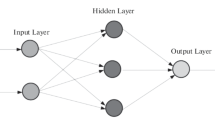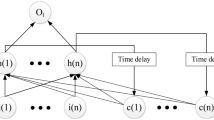Abstract
Accurate and reliable monthly runoff forecasting is of great significance for water resource optimization and management. A neoteric hybrid model based on variational mode decomposition (VMD) and gradient boosting regression (GBRT) called VMD-GBRT was proposed and applied for monthly runoff forecasting. VMD was first employed to decompose the original monthly runoff series into several intrinsic mode functions (IMFs). The optimal number of input variables were then chosen according to the autocorrelation function (ACF) and the partial autocorrelation function (PACF). The trained GBRT model was used as a forecasting instrument to predict the testing set of each normalized subsequence. The ensemble forecasting result was finally generated by aggregating the prediction results of all subsequences. The proposed hybrid model was evaluated using an original monthly runoff series, from 1/1969 to 12/2018, measured at the Huaxian, Lintong and Xianyang hydrological stations in the Wei River Basin (WRB), China. The EEMD-GBRT, the single GBRT, and the single SVM were adopted as comparative forecast models using the same dataset. The results indicated that the VMD-GBRT model exhibited the best forecasting performance among all the peer models in terms of the coefficient of determination (R2 = 0.8840), mean absolute percentage error (MAPE = 19.7451), and normalized root-mean-square error (NRMSE = 0.3468) at Huaxian station. Furthermore, the model forecasting results applied at Lintong and Xianyang stations were consistent with those at Huaxian station. This result further verified the accuracy and stability of the VMD-GBRT model. Thus, the proposed VMD-GBRT model was effective method for forecasting non-stationary and non-linear runoff series, and can be recommended as a promising model for monthly runoff forecasting.












Similar content being viewed by others
References
Abbot J, Marohasy J (2012) Application of artificial neural networks to rainfall forecasting in Queensland, Australia. Adv Atmos Sci 29(4):717–730
Abdoos AA (2016) A new intelligent method based on combination of VMD and ELM for short term wind power forecasting. Neurocomputing 203:111–120
Allawi MF, El-Shafie A (2016) Utilizing RBF-NN and ANFIS methods for multi-lead ahead prediction model of evaporation from reservoir. Water Resour Manag 30(13):4773–4788
Bai Y, Wang P, Xie JJ, Li JT, Li C (2015) Additive model for monthly reservoir inflow forecast. J Hydrologic Eng 20(7):04014079
Bai Y, Chen ZQ, Xie JJ, Li C (2016) Daily reservoir inflow forecasting using multiscale deep feature learning with hybrid models. J Hydrol 532:193–206
Barge JT, Sharif HO (2016) An ensemble empirical mode decomposition, self-organizing map, and linear genetic programming approach for forecasting river streamflow. Water 8(2):247
Bittelli M, Tomei F, Pistocchi A, Flury M, Boll J, Brooks ES, Antolini G (2010) Development and testing of a physically based, three-dimensional model of surface and subsurface hydrology. Adv Water Resour 33(1):106–122
Box GE, Jenkins GM, Reinsel GC, Ljung GM (2015) Time series analysis: forecasting and control. John Wiley & Sons
Chang JX, Wang YM, Istanbulluoglu E, Bai T, Huang Q, Yang DW, Huang SZ (2015) Impact of climate change and human activities on runoff in the Weihe River basin, China. Quat Int 380:169–179
Chang JX, Zhang HX, Wang YM, Zhu YL (2016) Assessing the impact of climate variability and human activities on streamflow variation. Hydrol Earth Syst Sci 20(4):1547–1560
Cheng CT, Chau K, Sun YG, Lin JY (2005) Long-term prediction of discharges in Manwan reservoir using artificial neural network models. Lect Notes Comput Sci 3498:1040–1045
Cheng CT, Feng ZK, Niu WJ, Liao SL (2015) Heuristic methods for reservoir monthly inflow forecasting: a case study of Xinfengjiang reservoir in Pearl River, China. Water 7(8):4477–4495
Di CL, Yang XH, Wang XC (2014) A four-stage hybrid model for hydrological time series forecasting. PLoS One 9(8):e104663
Dragomiretskiy K, Zosso D (2014) Variational mode decomposition. IEEE Trans Signal Process 62(3):531–544
Elith J, Leathwick JR, Hastie T (2008) A working guide to boosted regression trees. J Anim Ecol 77(4):802–813
Escalante-Sandoval C, Amores-Rovelo L (2019) Regional monthly runoff forecast in southern Canada using ANN, K-means, and L-moments techniques. Canadian Water Resources Journal. https://doi.org/10.1080/07011784.2019.1662095
Feng Q, Wen XH, Li JG (2015) Wavelet analysis-support vector machine coupled models for monthly rainfall forecasting in arid regions. Water Resour Manag 29(4):1049–1065
Friedman JH (2001) Greedy function approximation: a gradient boosting machine. Annal Stat 29(5):1189–1232
Gholami V, Chau KW, Fadaee F, Torkaman J, Ghaffari A (2015) Modeling of groundwater level fluctuations using dendrochronology in alluvial aquifers. J Hydrol 529(3):1060–1069
Guo J, Zhou JZ, Qin H, Zou Q, Li QQ (2011) Monthly streamflow forecasting based on improved support vector machine model. Expert Syst Appl 38(10):13073–13081
He ZB, Wen XH, Liu H, Du J (2014) A comparative study of artificial neural network, adaptive neuro fuzzy inference system and support vector machine for forecasting river flow in the semiarid mountain region. J Hydrol 509:379–386
Huang NE, Shen Z, Long SR, Wu MC, Shih HH, Zheng QA, Yen NC, Tung CC, Liu HH (1998) The empirical mode decomposition and the Hilbert spectrum for nonlinear and non-stationary time series analysis. Proc R Soc Lond A 454:903–995
Huang SZ, Chang JX, Huang Q, Chen YT (2014) Monthly streamflow prediction using modified EMD-based support vector machine. J Hydrol 511:764–775
Jang J-SR (1993) ANFIS: adaptive-network-based fuzzy inference system. IEEE Trans Syst Man Cy 23(3):665–685
Jiang RG, Wang YP, Xie JC, Zhao Y, Li FW, Wang XJ (2019) Assessment of extreme precipitation events and their teleconnections to El Nino southern oscillation, a case study in the Wei River basin of China. Atmos Res 218:372–384
Kim TW, Valdes JB (2003) Nonlinear model for drought forecasting based on a conjunction of wavelet transforms and neural networks. J Hydrol Eng 8:319–328
Lahmiri S (2015) Long memory in international financial markets trends and short movements during 2008 financial crisis based on variational mode decomposition and detrended fluctuation analysis. Phys. A, stat. Mech. Appl 437:130–138
Lahmiri S (2017) Comparing variational and empirical mode decomposition in forecasting day-ahead energy prices. IEEE Syst J 11(3):1907–1910
Lahmiri S, Boukadoum M (2014) Biomedical image denoising using variational mode decomposition. IEEE BIOCAS:340–343
Landry M, Erlinger TP, Patschke D, Varrichio C (2016) Probabilistic gradient boosting machines for GEFCom2014 wind forecasting. Int J Forecast 32(3):1061–1066
Lin YH, Chiu CC, Lee PC, Lin YJ (2012) Applying fuzzy grey modification model on inflow forecasting. Eng Appl Artif Intell 25(4):734–743
Maity R, Bhagwat PP, Bhatnagar A (2010) Potential of support vector regression for prediction of monthly streamflow using endogenous property. Hydrol Process 24(7):917–923
Naik J, Satapathy P, Dash PK (2018) Short-term wind speed and wind power prediction using hybrid empirical mode decomposition and kernel ridge regression. Appl Soft Comput 70(1):1167–1188
Natekin A, Knoll A (2013) Gradient boosting machines, a tutorial. Front. Neurorob 7:UNSP21
Okkan U, Serbes ZA (2012) Rainfall-runoff modeling using least squares support vector machines. Environmetrics 23(6):549–564
Pedregosa F, Varoquaux G, Gramfort A, Michel V, Thirion B, Grisel O, Blondel M, Prettenhofer P, Weiss R, Dubourg V, Vanderplas J, Passos A, Cournapeau D, Brucher M, Perrot M, Duchesnay E (2011) Scikit-learn: machine learning in python. J Mach Learn Res 12:2825–2830
Persson C, Bacher P, Shiga T, Madsen H (2017) Multi-site solar power forecasting using gradient boosted regression trees. Sol Energy 150:423–436
Su JQ, Wang X, Liang Y, Chen B (2014) GA-based support vector machine model for the prediction of monthly reservoir storage. J Hydrol Eng 19(7):1430–1437
Suryanarayana C, Sudheer C, Mahammood V, Panigrahi BK (2014) An integrated wavelet-support vector machine for groundwater level prediction in Visakhapatnam, India. Neurocomputing 145:324–335
Talei A, Chua LHC, Wong TS (2010) Evaluation of rainfall and discharge inputs used by adaptive network-based fuzzy inference systems (ANFIS) in rainfall-runoff modeling. J Hydrol 391(3):248–262
Wang WC, Chau KW, Cheng CT, Qiu L (2009) A comparison of performance of several artificial intelligence methods for forecasting monthly discharge time series. J Hydrol 374(3–4):294–306
Xie T, Zhang G, Hou JW, Xie JC, Lv M, Liu FC (2019) Hybrid forecasting model for non-stationary daily runoff series: a case study in the Han River basin, China. J Hydrol 577:UNSP 123915
Yang TT, Asanjan AA, Welles E, Gao XG, Sorooshian S, Liu XM (2017) Developing reservoir monthly inflow forecasts using artificial intelligence and climate phenomenon information. Water Resour Res 53(4):2786–2812
Yaseen ZM, Kisi O, Demir V (2016) Enhancing long-term streamflow forecasting and predicting using periodicity data component: application of artificial intelligence. Water Resour Manag 30(12):4125–4151
Yu PS, Chen ST, Chang IF (2006) Support vector regression for real-time flood stage forecasting. J Hydrol 328:704–716
Yu X, Zhang XQ, Qin H (2018) A data-driven model based on Fourier transform and support vector regression for monthly reservoir inflow forecasting. J Hydro Environ Res 18:12–24
Zhang YR, Haghani A (2015) A gradient boosting method to improve travel time prediction. Transportation Research Part C-Emerging Technologies 58(B):308–324
Zhang XY, Zhou JZ (2013) Multi-fault diagnosis for rolling element bearings based on ensemble empirical mode decomposition and optimized support vector machines. Mech Syst Signal Process 41(1–2):127–140
Zhang FM, Zhu XY, Hu T, Guo W, Chen C, Liu LJ (2016) Urban link travel time prediction based on a gradient boosting method considering spatiotemporal correlations. ISPRS Int Geo-Inf 5(11):201–225
Zou L, Xia J, She DX (2018) Analysis of impacts of climate change and human activities on hydrological drought: a case study in the Wei River basin, China. Water Resour Manag 32(4):1421–1438
Acknowledgments
This work was supported by the National Key R&D Program of China under Grant No. 2016YFC0401409; the National Natural Science Foundation of China under Grant Nos. 51679186, 51679188, and 51709222; and the Research Fund of the State Key Laboratory of Eco-hydraulics in Northwest Arid Region under Grant No. 2019KJCXTD-5.
Author information
Authors and Affiliations
Corresponding author
Ethics declarations
Conflict of Interest Statement
The authors declare no conflicts of interest.
Additional information
Publisher’s Note
Springer Nature remains neutral with regard to jurisdictional claims in published maps and institutional affiliations.
Rights and permissions
About this article
Cite this article
He, X., Luo, J., Li, P. et al. A Hybrid Model Based on Variational Mode Decomposition and Gradient Boosting Regression Tree for Monthly Runoff Forecasting. Water Resour Manage 34, 865–884 (2020). https://doi.org/10.1007/s11269-020-02483-x
Received:
Accepted:
Published:
Issue Date:
DOI: https://doi.org/10.1007/s11269-020-02483-x




